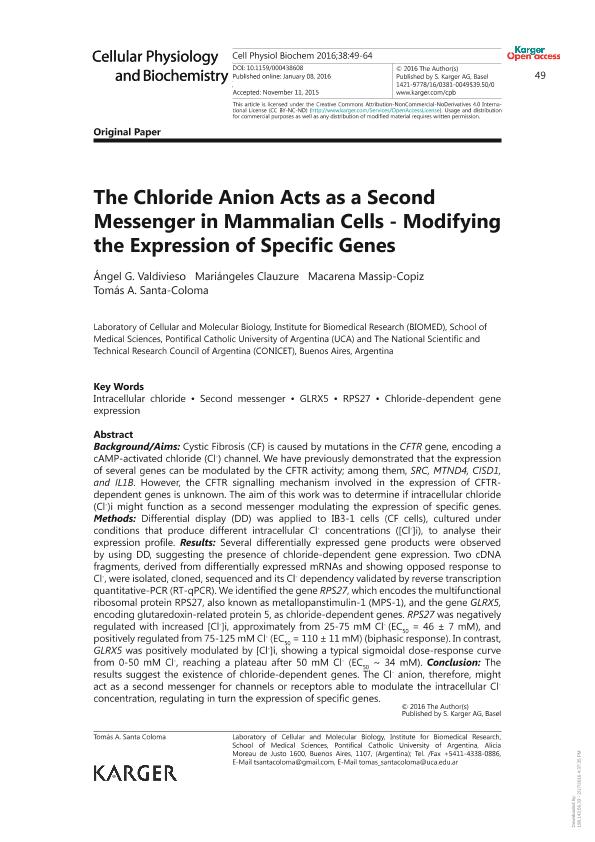Mostrar el registro sencillo del ítem
dc.contributor.author
Valdivieso, Ángel Gabriel

dc.contributor.author
Clauzure, Mariangeles

dc.contributor.author
Massip Copiz, María Macarena

dc.contributor.author
Santa Coloma, Tomás Antonio

dc.date.available
2018-03-14T18:03:42Z
dc.date.issued
2016-01
dc.identifier.citation
Valdivieso, Ángel Gabriel; Clauzure, Mariangeles; Massip Copiz, María Macarena; Santa Coloma, Tomás Antonio; The Chloride Anion Acts as a Second Messenger in Mammalian Cells: Modifying the Expression of Specific Genes; Karger; Cellular Physiology and Biochemistry; 38; 1; 1-2016; 49-64
dc.identifier.issn
1015-8987
dc.identifier.uri
http://hdl.handle.net/11336/38742
dc.description.abstract
Background/Aims: Cystic Fibrosis (CF) is caused by mutations in the CFTR gene, encoding a cAMP-activated chloride (Cl-) channel. We have previously demonstrated that the expression of several genes can be modulated by the CFTR activity; among them, SRC, MTND4, CISD1, and IL1B. However, the CFTR signalling mechanism involved in the expression of CFTR-dependent genes is unknown. The aim of this work was to determine if intracellular chloride (Cl-)i might function as a second messenger modulating the expression of specific genes. Methods: Differential display (DD) was applied to IB3-1 cells (CF cells), cultured under conditions that produce different intracellular Cl- concentrations ([Cl-]i), to analyse their expression profile. Results: Several differentially expressed gene products were observed by using DD, suggesting the presence of chloride-dependent gene expression. Two cDNA fragments, derived from differentially expressed mRNAs and showing opposed response to Cl-? were isolated, cloned, sequenced and its Cl- dependency validated by reverse transcription quantitative-PCR (RT-qPCR). We identified the gene RPS27, which encodes the multifunctional ribosomal protein RPS27, also known as metallopanstimulin-1 (MPS-1), and the gene GLRX5, encoding glutaredoxin-related protein 5, as chloride-dependent genes. RPS27 was negatively regulated with increased [Cl-]i, approximately from 25-75 mM Cl- (EC50 = 46 ± 7 mM), and positively regulated from 75-125 mM Cl- (EC50 = 110 ± 11 mM) (biphasic response). In contrast, GLRX5 was positively modulated by [Cl-]i, showing a typical sigmoidal dose-response curve from 0-50 mM Cl-, reaching a plateau after 50 mM Cl- (EC50 ∼ 34 mM). Conclusion: The results suggest the existence of chloride-dependent genes. The Cl- anion, therefore, might act as a second messenger for channels or receptors able to modulate the intracellular Cl- concentration, regulating in turn the expression of specific genes.
dc.format
application/pdf
dc.language.iso
eng
dc.publisher
Karger

dc.rights
info:eu-repo/semantics/openAccess
dc.rights.uri
https://creativecommons.org/licenses/by-nc-nd/2.5/ar/
dc.subject
Glrx5
dc.subject
Rps27
dc.subject
Chloride Dependent-Gene Expression
dc.subject
Intracellular Chloride
dc.subject.classification
Otras Ciencias Biológicas

dc.subject.classification
Ciencias Biológicas

dc.subject.classification
CIENCIAS NATURALES Y EXACTAS

dc.title
The Chloride Anion Acts as a Second Messenger in Mammalian Cells: Modifying the Expression of Specific Genes
dc.type
info:eu-repo/semantics/article
dc.type
info:ar-repo/semantics/artículo
dc.type
info:eu-repo/semantics/publishedVersion
dc.date.updated
2018-03-14T17:13:32Z
dc.journal.volume
38
dc.journal.number
1
dc.journal.pagination
49-64
dc.journal.pais
Suiza

dc.journal.ciudad
Basilea
dc.description.fil
Fil: Valdivieso, Ángel Gabriel. Pontificia Universidad Católica Argentina ; Argentina
dc.description.fil
Fil: Clauzure, Mariangeles. Pontificia Universidad Católica Argentina ; Argentina
dc.description.fil
Fil: Massip Copiz, María Macarena. Pontificia Universidad Católica Argentina ; Argentina
dc.description.fil
Fil: Santa Coloma, Tomás Antonio. Pontificia Universidad Católica Argentina ; Argentina
dc.journal.title
Cellular Physiology and Biochemistry

dc.relation.alternativeid
info:eu-repo/semantics/altIdentifier/url/https://www.karger.com/Article/FullText/438608
dc.relation.alternativeid
info:eu-repo/semantics/altIdentifier/doi/http://dx.doi.org/10.1159/000438608
Archivos asociados
